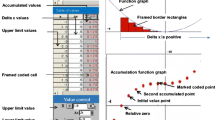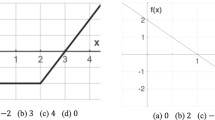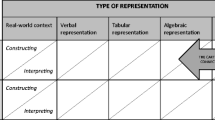Abstract
The present study focuses on the accumulation process involved in the integration of a single-variable function. Observing the work of two high-school calculus students who had not yet learned any other integral-related ideas, we analyze the emergence of the semiotic relationship between personal and mathematical meanings, as expressed through the understanding of mathematical signs in integration tasks. Adopting Radford's educational perspective whereby learning is defined as a process of objectification, we identify a three-stage evolution of the double semiotic meaning of the lower boundary and of its role in the definition of the accumulation graph: (1) objectifying a zero accumulation in relation to the lower limit, (2) objectifying zero as marking the zero sum of accumulated areas, and (3) objectifying the accumulation graph as dependent on the lower-limit value. This evolution is marked by semiotic changes related to the pivotal role of the “zeros” in the accumulation graph.











Similar content being viewed by others
References
Arzarello, F., Robutti, O., & Bazzini, L. (2005). Acting is learning: Focus on the construction of mathematical concepts. Cambridge Journal of Education, 35(1), 55–67.
Bartolini Bussi, M. G., & Mariotti, M. A. (2008). Semiotic mediation in the mathematics classroom: Artifacts and signs after a Vygotskian perspective. In L. English, M. Bartolini Bussi, G. A. Jones, R. A. Lesh, & D. Tirosh (Eds.), Handbook of international research in mathematics education (Second revisedth ed., pp. 746–783). Mahwah: Lawrence Erlbaum.
Berger, M. (2004). The functional use of a mathematical sign. Educational Studies in Mathematics, 55(1–3), 81–102.
Botzer, G., & Yerushalmy, M. (2008). Embodied semiotic activities and their role in the construction of mathematical meaning of motion graphs. International Journal of Computers for Mathematical Learning, 13(2), 111–134. doi:10.1007/s10758-008-9133-7.
Carlson, M., Persson, J., & Smith, N. (2003). Developing connecting calculus students' notions of rate-of-change an accumulation: The fundamental theorem of calculus. In N. Pateman, B. Dougherty, & J. Zilliox (Eds.), Proceedings of the 27th conference of the International Group for the Psychology of Mathematics Education (vol. 2, pp. 165–172). Honolulu, USA.
Freese, R., & Stegenga, D. (2000, February 6). Calculus concepts using Derive for windows. Available from: http://www.math.hawaii.edu/RDPublishing/CalcLabBook/course-use.html. Accessed 12 February 2011
Kaskosz, B. (2004). An anti-derivative plotter: Accumulated change, the definite integral in terms of areas. Available from: http://www.flashandmath.com/mathlets/calc/antplot/antplot.html. Accessed Retrieved 10 February 2011
Kouropatov, A., & Dreyfus, T. (2009). Integral as accumulation: A didactical perspective for school mathematics. In M. Tzekaki, Kaldrimidou, M. & Sakonidis, H. (Eds.), Proceedings of the 33th conference of the International Group for the Psychology of Mathematics Education (Vol. 3, pp. 417–424). Thessaloniki, Greece.
Machin, M., & Rivero, R. (2003). Using Derive to understand the concept of definite integral. International Journal for Mathematics Teaching and Learning, 3, 1–16.
Orton, A. (1983). Students' understanding of integration. Educational Studies in Mathematics, 14(1), 1–18.
Radford, L. (2003). Gestures, speech, and the sprouting of signs: A semiotic-cultural approach to students’ types of generalization. Mathematical Thinking and Learning, 5(1), 37–70.
Radford, L. (2005). Body, tool, and symbol: Semiotic reflections on cognition. In E. Simmt & B. Davis (Eds.), Proceedings of the 2004 Annual Meeting of the Canadian Mathematics Education Study Group (pp. 111–117). Québec: Université Laval.
Radford, L. (2008). The ethics of being and knowing: Towards a cultural theory of learning. In L. Radford, G. Schubring, & F. Seeger (Eds.), Semiotics in mathematics education: Epistemology, history, classroom, and culture (pp. 215–234). Rotterdam: Sense Publishers.
Radford, L. (2010). Signs, gestures, meanings: Algebraic thinking from a cultural semiotic perspective. In V. Durand-Guerrier, S. Soury-Lavergne, & F. Arzarello (Eds.), Proceedings of the Sixth Conference of European Research in Mathematics Education (CERME 6) (pp. 33–53). Lyon, France: Université Claude Bernard.
Radford, L., Bardini, C., & Sabena, C. (2007). Perceiving the general: The multisemiotic dimension of students’ algebraic activity. Journal for Research in Mathematics Education, 38(5), 507–530.
Radford, L., Bardini, C., Sabena, C., Diallo, P., & Simbagoye, A. (2005). On embodiment, artifacts, and signs: A semiotic-cultural perspective on mathematical thinking. In H. L. Chick & J. L. Vincent (Eds.), Proceedings of the 29th conference of the International Group for the Psychology of Mathematics Education, vol. 4 (pp. 113–120). Australia: University of Melbourne.
Rasslan, S., & Tall, D. (2002). Definitions and images for the definite integral concept. In A. Cockburn & E. Nardi (Eds.), Proceedings of the 26th conference of the International Group for the Psychology of Mathematics Education, vol. 4 (pp. 89–96). United Kingdom: Norwich.
Rösken, B., & Rolka, K. (2007). Integrating intuition: The role of concept image and concept definition for students' learning of integral calculus. The Montana Mathematics Enthusiast, 3, 181–204.
Schwartz, J.L., & Yerushalmy, M. (1996). Calculus Unlimited [computer software]. Available from: http://www.cet.ac.il/math-international/software7.htm. Accessed Retrieved 10 February 2011
Tall, D. (2009). Dynamic mathematics and the blending of knowledge structures in the calculus. ZDM – The International Journal on Mathematics Education, 41(4), 481–492.
Thompson, P. W. (1994). Images of rate and operational understanding of the fundamental theorem of calculus. Educational Studies in Mathematics, 26(2–3), 229–274.
Thompson, P. W., & Silverman, J. (2008). The concept of accumulation in calculus. In M. P. Carlson & C. Rasmussen (Eds.), Making the connection: Research and teaching in undergraduate mathematics (pp. 43–52). Washington, DC: Mathematical Association of America.
Wolfram Alpha. (2010). Integrator. Available from: http://www.wolframalpha.com/input/?i=integral. Accessed 10 February 2011
Author information
Authors and Affiliations
Corresponding author
Rights and permissions
About this article
Cite this article
Yerushalmy, M., Swidan, O. Signifying the accumulation graph in a dynamic and multi-representation environment. Educ Stud Math 80, 287–306 (2012). https://doi.org/10.1007/s10649-011-9356-8
Published:
Issue Date:
DOI: https://doi.org/10.1007/s10649-011-9356-8




